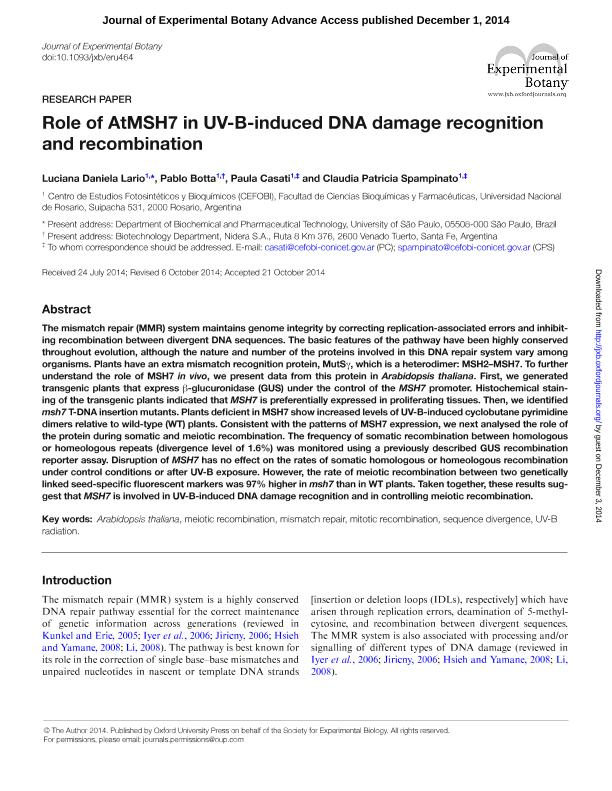Artículo
Role of AtMSH7 in UV-B-induced DNA damage recognition and recombination
Fecha de publicación:
12/2014
Editorial:
Oxford University Press
Revista:
Journal Of Experimental Botany
ISSN:
0022-0957
Idioma:
Inglés
Tipo de recurso:
Artículo publicado
Clasificación temática:
Resumen
The mismatch repair (MMR) system maintains genome integrity by correcting replication associated errors and inhibiting recombination between divergent DNA sequences. The basic features of the pathway have been highly conserved throughout evolution, although the nature and number of the proteins involved in this DNA repair system vary among organisms. Plants have an extra mismatch recognition protein, named MutS. The protein is a heterodimer of MSH2?MSH7. To further understand the in vivo role of MSH7, we present data from this protein in Arabidopsis thaliana plants. First, we generated transgenic plants that express the β-glucuronidase (GUS) under the control of the MSH7 promoter. Histochemical staining of the transgenic plants indicated that MSH7 is preferentially expressed in proliferating tissues. Then, we identified msh7 T-DNA insertion mutants. Plants deficient in MSH7 show increased levels of UV-B-induced cyclobutane pyrimidine dimers (CPDs) relative to wild-type (WT) plants. Consistent with the patterns of MSH7 expression, we next analyzed the role of the protein during somatic and meiotic recombination. The frequency of somatic recombination between homologous or homeologous repeats (divergence level of 1.6%) was monitored using a previously described GUS recombination reporter assay. Disruption of MSH7 has no effect on the rates of somatic homologous or homeologous recombination under control conditions or after UV-B exposure. However, the rate of meiotic recombination between two genetically linked seed-specific fluorescent markers was 97% higher in msh7 than in WT plants. Taken together, these results suggest that MSH7 is involved in UV-B-induced DNA damage recognition and in controlling meiotic recombination.
Archivos asociados
Licencia
Identificadores
Colecciones
Articulos(CEFOBI)
Articulos de CENTRO DE EST.FOTOSINTETICOS Y BIOQUIMICOS (I)
Articulos de CENTRO DE EST.FOTOSINTETICOS Y BIOQUIMICOS (I)
Citación
Lario, Luciana Daniela; Botta, Pablo Eduardo; Casati, Paula; Spampinato, Claudia Patricia; Role of AtMSH7 in UV-B-induced DNA damage recognition and recombination; Oxford University Press; Journal Of Experimental Botany; 66; 11; 12-2014; 3019-3026
Compartir
Altmétricas




